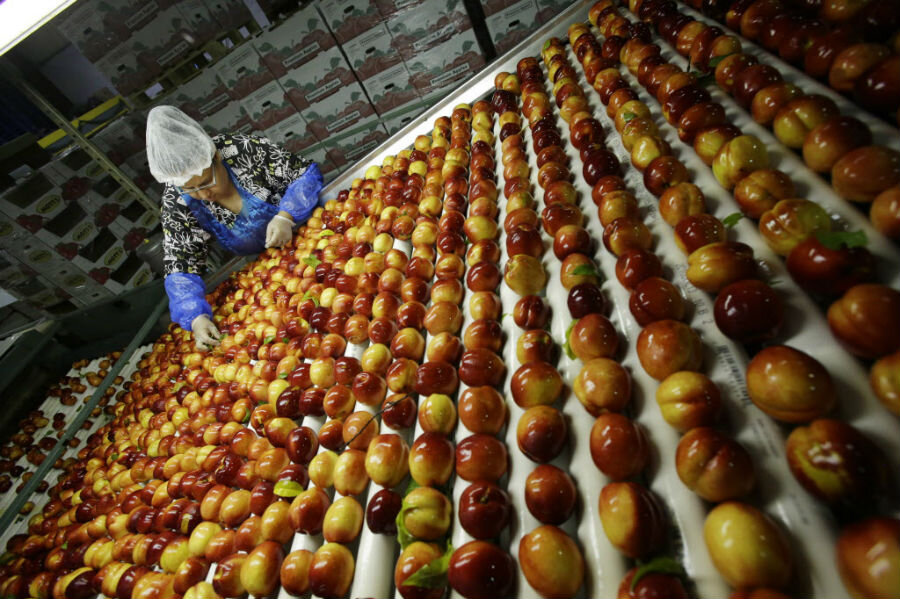Could Massachusetts food waste ban be a road map for the rest of the country?
| Boston
On a Monday morning in the Boston University food court, students toss plates of food in bins with multicolored labels: green for recycling, black for landfill, and yellow for compostables.
“We capture as much food waste and organic material as we can,” says Sabrina Pashtan, Sustainability Coordinator at Boston University Dining Services. “That spans everything from scraps in the dining hall to leftover food and napkins in student meals to compostable plates in the food court to catered dinner for 500 people.”
All told, the university diverts around 800 tons of food waste each year, averaging out to about 15 tons of food waste per week, Ms. Pashtan says.
That came in handy when Massachusetts implemented a new law in October saying that any institution that produces at least one ton of food waste per week cannot put it in a landfill.
Americans throw away about 40 percent of their food – that’s $165 billion worth of food waste feeding landfills each year, according to a 2012 report from the Natural Resources Defense Council (NRDC).
Because many landfills are reaching capacity and are heavy contributors of greenhouse gases – the Environmental Protection Agency ranks them as the third largest source of methane gas emissions in the US – some policymakers are looking for alternatives.
In recent years, a small handful of US cities and states have passed laws aimed at reducing the amount of food waste rotting in landfills. In 2011, Connecticut became the first state to ban commercial food waste from landfills. Vermont followed suit the following year. Seattle, San Francisco, and Portland, Ore., also have commercial food waste bans. A similar law will go into effect in New York City on July 1, 2015.
The Massachusetts law is part of a broader statewide goal to reduce solid waste by 80 percent of 1990 levels by 2050. The state disposed of 4.9 million tons of solid waste in 2011, about 17 percent of which was food waste, according to the most recent data provided by the state Department of Environmental Protection.
Massachusetts’s efforts could potentially become a road map for the rest of the nation, says Dana Gunders, a staff scientist for the NRDC and author of the 2012 report. Diverting food scraps from landfills to composters not only reduces greenhouse gasses given off by rotting food, but also recycles food nutrients into future crops.
However, the Massachusetts ban does not specify where the waste must go. And for many, this question is the crux of the matter.
"It doesn't address where is it gonna go, whether it's more expensive. It doesn't address whether it has to be shipped 300 miles. It doesn't address a whole boatload of things," Steve Changaris, of the National Waste and Recycling Association, said in an interview with NPR.
DEP Commissioner David Cash says that he hopes the ban will spur innovation to make diverting food waste economically viable.
He cites the relationship between Barstow’s Longview Farm in Hadley, Mass., and Cabot Creamery in West Springfield, Mass., as an example of a symbiotic relationship the ban might inspire between producers of food waste and composters. The Barstows produce milk for Cabot. Cabot uses the milk to make butter and then sends the waste back to the Barstows. That food waste is then mixed with manure in the farm’s anaerobic digester to produce energy to power the farm.
Because food waste can be used to create energy, Mr. Cash says it is coming to be seen as a commodity. “Some [haulers] are even taking away the waste for free,” he says.
Like Massachusetts, Vermont relies in part on anaerobic digestion. It has 17 digesters on farms throughout the state that mainly process cow manure to produce heat and power.Adding food scraps to the manure can greatly increase the energy potential of a digester, says Josh Kelly, an environmental analyst in the solid waste program in the Vermont Agency of Natural Resources.
NRDC's Gunders agrees. She says anaerobic digestion has “great potential,” but if the material produced from the digester is not composted properly it can have negative environmental impacts.
However, Ms. Gunders says she would rather see Americans reduce the amount of food they waste rather than rely on fuel digesters and composters. Reducing food waste by just 15 percent could feed an additional 25 million Americans every year, her 2012 report estimates.
“The hope is that [the ban] will result in preventing waste from occurring in the first place and lead to less surplus food overall rather than just redirecting it to composting.”
Cash admits the ban is only a start. It impacts the largest producers of food waste in the state – around 1,700 institutions. That means Massachusetts will only be diverting around seven Fenway parks worth of food waste each year, Cash says. Still, he says, “we have only heard positive things about the ban so far.”
But according to Gunders, Massachusetts’ ban correlates with the gradual improvements she has seen on a larger scale across the country. She cites increased awareness of the issue of food waste and the new interest in developing innovations to address it as evidence that the country is making progress.
She adds that this is something all people need to be aware of, not just governments and businesses.
“While the Massachusetts ban is a commercial ban, this really is something that we’re all part of and we can all start to change right away,” she says.
Such change often starts with a simple message. According to Cash, one of the biggest hurdles has been to communicate to affected businesses how best to implement this ban.
Back at Boston University, Pashtan agrees. Often, she says, the best methods to change student behavior are simple signs telling them how to compost their waste. But “it’s challenging,” she says.
Still, she grins as she surveys the various utensils located next to the different waste bins in the BU food court.
“These are all compostable,” she says, gesturing toward what appear to be ordinary plastic forks and knives. She adds, “They’re made of corn starch.”







